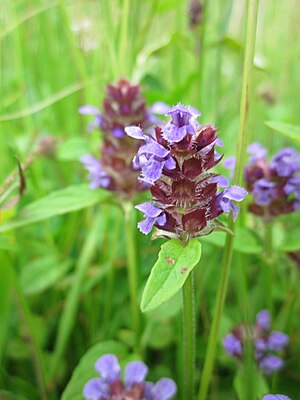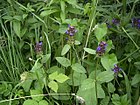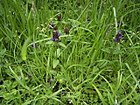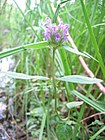Note: This is a project under development. The articles on this wiki are just being initiated and broadly incomplete. You can Help creating new pages.
Prunella vulgaris - Self heal
Prunella vulgaris is an herbaceous plant in the genus Prunella.
Contents
[hide]- 1 Uses
- 2 Parts Used
- 3 Chemical Composition
- 4 Common names
- 5 Properties
- 6 Habit
- 7 Identification
- 8 List of Ayurvedic medicine in which the herb is used
- 9 Where to get the saplings
- 10 Mode of Propagation
- 11 How to plant/cultivate
- 12 Commonly seen growing in areas
- 13 Photo Gallery
- 14 References
- 15 External Links
Uses
High blood pressure, Fever, Weaknesses, Hemorrhoids, Vaginal pain, Conjunctivitis., Sore throats, Diarrhea, Sore throats, Eczema , Psoriasis.
Parts Used
Chemical Composition
Contains volatile oils, flavonoids, apigenin, luteolin, quercetin, kaempferol, tiliroside, triterpene glycosides including euscapic acid and tormentic acid, phenolic acids, and 3%–21% tannins.[1]
Common names
| Language | Common name |
|---|---|
| Kannada | |
| Hindi | |
| Malayalam | |
| Tamil | |
| Telugu | |
| Marathi | NA |
| Gujarathi | NA |
| Punjabi | NA |
| Kashmiri | NA |
| Sanskrit | |
| English | Herbaceous plant |
Properties
Reference: Dravya - Substance, Rasa - Taste, Guna - Qualities, Veerya - Potency, Vipaka - Post-digesion effect, Karma - Pharmacological activity, Prabhava - Therepeutics.
Dravya
Rasa
Tikta (Bitter), Kashaya (Astringent)
Guna
Laghu (Light), Ruksha (Dry), Tikshna (Sharp)
Veerya
Ushna (Hot)
Vipaka
Katu (Pungent)
Karma
Kapha, Vata
Prabhava
Habit
Identification
Leaf
| Kind | Shape | Feature |
|---|---|---|
| Simple | Opposite | Leaves narrow-to ovate-oblong, to 5 x 2.5 cm, base cuneate, margin subentire, apex obtuse, pilose; petiole to 2 cm. |
Flower
| Type | Size | Color and composition | Stamen | More information |
|---|---|---|---|---|
| Bisexual | Terminal spikes | Pinkish purple | 4 | Verticillate, to 3 x 2.5 cm(elongating to 5 cm in fruit), with flowers in whorls of 6; floral bracts leafy, ovate, to 6 x 4 mm, margin ciliate, purplish. |
Fruit
| Type | Size | Mass | Appearance | Seeds | More information |
|---|---|---|---|---|---|
| Nutlet | Oblong, smooth | {{{6}}} |
Other features
List of Ayurvedic medicine in which the herb is used
Where to get the saplings
Mode of Propagation
How to plant/cultivate
Easy to grow plant for any soil in full sun or partial shade. May be considered invasive. Attract bees and other beneficial insects. Good ground cover.[3]
Commonly seen growing in areas
Terrain region, At grassland area, Woodland edges, At roadsides, In wastelands.
Photo Gallery
References
External Links
- Ayurvedic Herbs known to be helpful to treat High blood pressure
- Ayurvedic Herbs known to be helpful to treat Fever
- Ayurvedic Herbs known to be helpful to treat Weaknesses
- Ayurvedic Herbs known to be helpful to treat Hemorrhoids
- Ayurvedic Herbs known to be helpful to treat Vaginal pain
- Ayurvedic Herbs known to be helpful to treat Conjunctivitis.
- Ayurvedic Herbs known to be helpful to treat Sore throats
- Ayurvedic Herbs known to be helpful to treat Diarrhea
- Ayurvedic Herbs known to be helpful to treat Eczema
- Ayurvedic Herbs known to be helpful to treat Psoriasis
- Herbs with Whole herb used in medicine
- Herbs with common name in English
- Habit - Herb
- Index of Plants which can be propagated by Seeds
- Herbs that are commonly seen in the region of Terrain region
- Herbs that are commonly seen in the region of At grassland area
- Herbs that are commonly seen in the region of Woodland edges
- Herbs that are commonly seen in the region of At roadsides
- Herbs that are commonly seen in the region of In wastelands
- Herbs
- Lamiaceae










